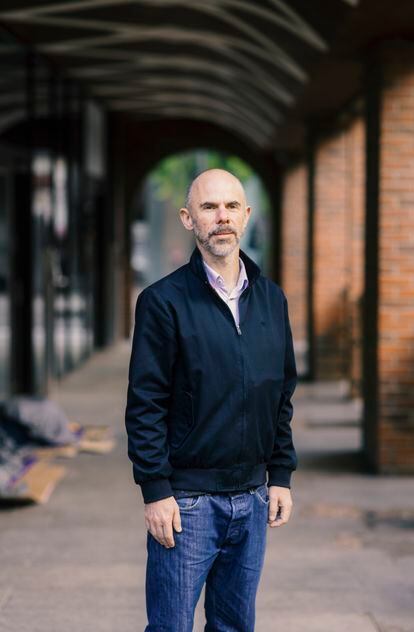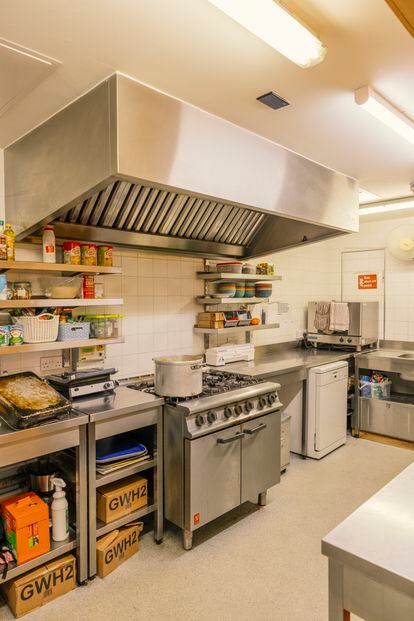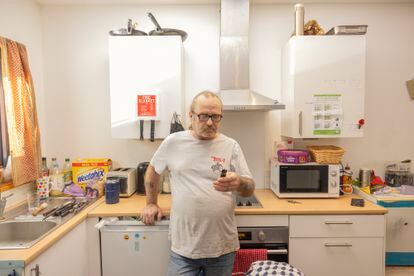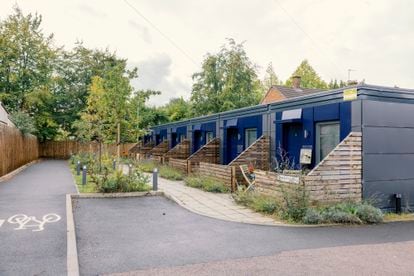Matt Wiseman has no idea what changed in his ninth detox attempt, what the hell he did differently than the previous eight he had failed at. The fact is that it worked that time. Surely that is why, 12 years later, among the keys that he describes for working with homeless people—the majority with mental problems and addictions—he places understanding and patience in a privileged place. “Never give up, that's what I learned,” he explains. And if it doesn't work one way, you try another and, if not, another, and another… That is precisely why we are here today, on a morning at the end of 2023, in a humble office of the NGO Jimmy's Cambridge, in the English municipality of the same name, known worldwide for its university. Because that philosophy is behind the idea that has turned this small organization—whose main driving force is that no one should sleep on the street—into a social innovation laboratory thanks to a pioneering project around four mini-developments of modular mini-houses. In total, there are 22 small spaces – 25 square meters -, complete and independent – with their furniture, their bathroom, their kitchen, their entrance porch -, but at the same time linked to other similar ones that offer them a community atmosphere. along with other residents in the same situation. They are for homeless people an intermediate step, supervised by NGO workers, on the rocky path that separates sleeping rough and completely taking back the reins of their lives.
Houses (built and assembled in a factory from modules, ready to be transported and placed wherever needed) have become a common tool to combat homelessness in a context of growing needs. In Europe there are almost 900,000 homeless people, 70% more than at the end of 2000, according to the European Federation of National Organizations Working with Homeless People; and in the US there are about 653,000, the highest number since the Government began recording this statistic in 2007. In Barcelona, for example, since 2019, the City Council has offered temporary accommodation in two floors of apartments built from recycled containers. In Los Angeles (USA), the Hilda L. Solis Care First Village was built during the pandemic, with 132 rooms, also built from shipping containers, in a complex that offers support services and a full commercial kitchen.
In addition to the negative connotations of the use of containers—at least, in terms of their initial perception—the Cambridge project presents significant differences. Located in the center of the city – close to services and employment possibilities – each of the houses, made mainly of laminated wood, allow for completely independent lives, which is important for countless reasons. Some, as unique as the fact of having pets, means that many homeless people do not want to use shelters, since they must leave their dogs or cats outside (this has been explained on more than one occasion by the social workers of the city of Madrid).
“In cities with so much pressure and so little space to build new homes, it is about using small free spaces and putting up those houses. And, in five or 10 years, you can take the crane, lift the modular homes and move them to another site,” explains Mark Allan, the CEO of Jimmy's Cambridge.


In a similar way to what Wiseman tells of his ninth attempt, Allan cannot explain exactly how and from whom the idea of tiny houses came about. He says that it was simply born from the meeting in the right place and at the right time of an NGO that was looking for a way to offer affordable homes quickly in a city as expensive as Cambridge (the average price of a home is 630,000 euros, 77% above the average for England, according to the British INE); another dedicated to offering innovative solutions for companies and organizations that want to have a social impact (Alia); a social enterprise of ethical construction (New Meaning Foundation), and a religious entity that had an empty lot available (the Church of Christ the Redeemer). “Nothing happens in isolation. It takes a community,” Allan insists.
This is how the first mini-urbanization was born in 2020 – later three more would arrive, with houses donated by the London company The Hill Group on land donated by the City Council – of six homes to the east of Cambridge, near the airport. Each of them has its porch and, unlike those that would arrive later, they also have a large common garden. Because if one of the keys is independence—the powerful image of your own door, which can be opened and closed whenever you feel like it—another is the possibility of connection so as not to feel isolated. “We have learned that a small number of units [tres de las urbanizaciones tienen seis casas, y la otra, cuatro] It is better to create a mini-community and it is very important to have a common space. That's what that big garden is for, because it creates a space where people can go out and get to know each other. That first urbanization is precisely the one that works best. It's not about just piling up houses,” explains Allan.
It is, in fact, about balances, but that also has a negative part that must be dealt with. “The sad thing is when you see someone doing very, very well, but you know that it is going to be very hard for them, that they are going to have to fight because their classmates from the other modules are not doing so well. “We’re looking for answers to that, but we haven’t found any yet,” explains Wisem
an. He has been with the project since the beginning and is now the head of the team that works with the residents; He is convinced that, when they manage to improve the process, “it will be a brilliant success.”
But he knows that the path to achieving it is not easy: he has seen tenants who have had to move to a shared apartment because they were victims of drug trafficking networks – they look for vulnerable people to take care of retail – to another with aggressive behaviors that had to be evicted – a process that is not easy – for attacking a neighbor with a golf club, to others who cannot overcome their addiction despite all their efforts. “The power of addiction still surprises me; Right now the worst thing is crack because it has no pharmacological substitute,” Wiseman sighs.
But he has also seen how some of them – so far, three – have managed to make the jump to their own apartment, others who are very close to getting it and some more who have stabilized their lives in these tiny houses and, in fact, do not want to. move from there. One of the proposals for improvement that the specialists from the University of Cambridge have put forward to them (who are evaluating the project from the beginning) is to make “the duration of the lease more flexible and extend it beyond the initial period of two years” to help “the residents to have more time to improve their circumstances before moving,” says the latest report from the Cambridge Housing and Planning Research Center.
This text also advises that, if possible, all mini-developments have a good common green space. And he applauds the NGO's decision to establish a pre-leasing period to try to predict whether the candidates – there are few houses, of course you have to choose who they are for – are going to adapt well. “It's not easy to accept the rules to begin with,” explains Wiesman. “For example, tenants have to be home at eleven at night, which means they are losing money; peak begging hours in Cambridge are from eleven at night to four in the morning. And they can earn up to 200 pounds a day,” she says. Residents also have to process the request for social assistance for rent (they pay about 200 euros per week) and in some cases they are asked to contribute to the maintenance of the houses and developments (about 11 euros per week), money with the NGO makes the necessary arrangements, pays its workers and pays all the bills: water, electricity, television, security cameras… And, although Jimmy's employees help them process it, there are more responsibilities that can overwhelm people. who have been living on the streets for a long time. Thus, an intermediate stage in a shelter, where they gradually become accustomed to rules and responsibilities, is proving to be really useful.
This was the path followed by Trevor, one of the residents of the first tiny houses for just over three years. Since his wife and son died in a traffic accident in 1999, Trevor's life began to go downhill – between drug use and crime to feed the beast, stays in jail and nights in the open – until he He crossed paths at the Primark door with one of Jimmy's Cambridge workers, Carol Fendick. After a year and a half in an NGO shelter, Travis moved to one of the tiny houses and, having regained much of his independence, he also took up his hobby of carpentry and found a way to stay clean to this day. Having turned 63, he assures that he is prepared to leave his tiny house to the next person who needs it.



The person who took him off the street is Carol Fendick. Today she directs another of the NGO's resources, Jimmy's 451, a residence with six rooms and shared spaces for people with especially complicated mental health and addiction problems. There, one day at the end of last year, she also talked about patience just before reminding a resident—clearly and deeply dazed by the effects of the drugs—that she had a doctor's appointment and couldn't miss it. She did it with that mixture of firmness and empathy that disarms whoever the interlocutor is. One of the big problems that Fendick – also Weisman and Allan – mentioned is that psychological and psychiatric help resources are prohibited to them until they are clean of their addiction. But that type of support is essential to get out of it.
Specialists speak of stories of abuse, violence and trauma that often go back to childhood, which are at the origin of a situation that has led them to sleep on the street and which will worsen exponentially with each day they spend outdoors. “Our goal is to get people off the streets as soon as possible. And then providing them with all the support they need to help them resolve whatever it was that led them to end up in the middle of the city,” explains Allan. And in that context that some have defined as a “global housing crisis,” his plan is to try again and again. Which translates, for example, into providing shelters, but also shared houses, or a
n “abstinence house” (for people who have just detoxified) or their newest modular mini-houses. Some tiny houses that may not be “in themselves a solution to a problem as complex as homelessness,” as the University of Cambridge researcher Richmond Juvenile Ehwi points out, but they are an option that may be what some—perhaps even many—it ended up working for them. Even if it's the ninth.
Subscribe to continue reading
Read without limits
_
#social #powers #modular #homes

